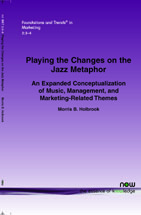Playing the Changes on the Jazz Metaphor: An Expanded Conceptualization of Music-, Management-, and Marketing-Related Themes
By Morris B. Holbrook, W. T. Dillard Professor of Marketing, Graduate School of Business, Columbia University, USA, mbh3@columbia.edu
Abstract
A metaphor based on the nature of jazz as a musical genre in general and on the sociopsychological process of jazz improvisation in particular has frequently surfaced in recent accounts of product innovation, brand positioning, team coordination, and organizational leadership from various areas of research on management and marketing strategy. As typically applied, this "jazz metaphor" appears unnecessarily limited in its scope. In this light, the author suggests a need for refining, extending, and enlarging the jazz metaphor to cover a broader range of music-, management-, and marketing-related themes. Toward this end, the author "plays the changes" on this perspective by developing a typology of jazz musicians based on different kinds of musical offerings and by elaborating this typology to propose a classification of management and marketing styles based on parallels with the jazz metaphor.
Playing the Changes on the Jazz Metaphor
Playing the Changes on the Jazz Metaphor proposes an expanded view of the jazz metaphor in a broadened perspective that embraces a wide range of possibilities in organizational, management, and marketing-related themes. This monograph presents a new Typology of Jazz Musicians based on different kinds of artistic offerings. This typology will combine three key distinctions or dimensions to construct a twelve-fold classification that - when extended to the sphere of organizational behavior and business strategy as a Typology of Management and Marketing Styles - will shed light on different ways in which the jazz metaphor relates to organizational design, business practice, management skills, and marketing opportunities. In order to describe these typologies, the author examines important aspects of a first-level jazz metaphor as it relates to organizational issues involved in shaping the jazz improvisation into a form of collective collaboration. This is followed by attention to a second-level linguistic metaphor based on viewing jazz as a kind of language at the foundation for a collaborative conversation.
